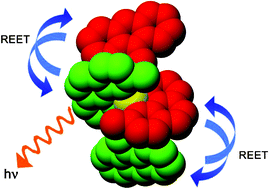Reversible electronic energy transfer: a means to govern excited-state properties of supramolecular systems
Abstract
A strategy to manage energy, following

* Corresponding authors
a
Groupe Nanostructures Organiques, Institut des Sciences Moléculaires, Université Bordeaux I/CNRS, UMR 5255, Talence, France
E-mail:
n.mc-clenaghan@ism.u-bordeaux1.fr
Fax: +33 54000 6158
Tel: +33 54000 3321
b
School of Chemistry, Centre for Synthesis and Chemical Biology, Dublin, Dublin 2, Ireland
E-mail:
linchenc@tcd.ie
c
Departamento de Química, REQUIMTE, Faculdade de Ciências e Tecnologia, Universidade NOVA de Lisboa, 2829-516 Caparica, Portugal
E-mail:
yoann.leydet@dq.fct.unl.pt
A strategy to manage energy, following

 Please wait while we load your content...
Something went wrong. Try again?
Please wait while we load your content...
Something went wrong. Try again?
A. Lavie-Cambot, C. Lincheneau, M. Cantuel, Y. Leydet and N. D. McClenaghan, Chem. Soc. Rev., 2010, 39, 506 DOI: 10.1039/B810669J
To request permission to reproduce material from this article, please go to the Copyright Clearance Center request page.
If you are an author contributing to an RSC publication, you do not need to request permission provided correct acknowledgement is given.
If you are the author of this article, you do not need to request permission to reproduce figures and diagrams provided correct acknowledgement is given. If you want to reproduce the whole article in a third-party publication (excluding your thesis/dissertation for which permission is not required) please go to the Copyright Clearance Center request page.
Read more about how to correctly acknowledge RSC content.
 Fetching data from CrossRef.
Fetching data from CrossRef.
This may take some time to load.
Loading related content
